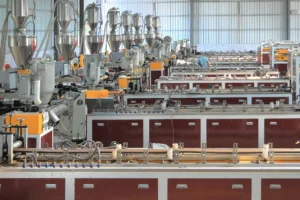Interface Modification Methods of Wood-Plastic Composites
Wood-plastic composite (WPC) materials are created by combining plant fibers with thermoplastic plastics. This unique material possesses the excellent processing characteristics of wood and the high-strength properties of plastic, making it widely applicable across various industries. The raw materials used in WPC are easily sourced, and the composite material enables the efficient recycling of solid waste, including used plastics and plant waste. As an environmentally friendly material, WPC has gained popularity, especially with the increasing diversification of plant-based raw materials, which helps adapt to different regional plant distributions. This also lowers costs and improves both economic benefits and environmental sustainability.
However, despite its advantages, WPCs often face challenges when it comes to the interaction between plant fibers and plastics. Plant fibers typically contain numerous polar groups, such as hydroxyl and phenolic hydroxyl groups, which do not easily bond with the non-polar surfaces of plastics. This results in poor interfacial fusion, which compromises the thermal deformation temperature and modulus of the composite. To address these issues and enhance the overall performance of WPC materials, interface modification is essential.

Methods of Interface Modification for WPCs
The interface of WPCs can be modified through several approaches: physical methods, chemical methods, and the addition of interface compatibilizers.
1. Physical Methods
Physical methods aim to alter the polarity of plant fibers by removing larger polar molecules. This helps improve the compatibility between the fibers and plastic matrix. Some common physical methods include:
- – Ion Discharge Treatment: This includes nitrogen jet plasma discharge technology and diffusion coplanar barrier discharge plasma treatment, which can modify the surface properties of the plant fibers.
- – Thermal Treatment: Heating the material can also change the interface properties by altering the structure of the fibers, enhancing their compatibility with plastics.
2. Chemical Methods
Chemical interface modification involves adding filler materials, surface discharge treatments, or heating processes to improve the bonding between plant fibers and plastics. Chemical reactions can also be used to alter the properties of the filler, matrix, or additives, thus enhancing the fiber-plastic interface. This reduces interface defects and improves overall material performance.
Some common chemical methods include:
- – Esterification: The reaction between butyric anhydride and lignin can significantly improve tensile strength.
- – Coupling Agents: Adding coupling agents can increase bending strength.
- – Grafting Treatment: This can significantly enhance the impact toughness of the material.
- – Acylation or Potassium Permanganate Treatment: These treatments improve the bonding strength of the material.
3. Adding Compatibilizers
The use of compatibilizers is a popular method for enhancing the interfacial properties of WPCs. These substances help bridge the gap between the polar plant fibers and the non-polar plastic matrix. Common compatibilizers include:
- – Maleic Anhydride Grafted Polymers
- – Silane Coupling Agents
While these materials show promise, their use can be complex and expensive. The research into more efficient, cost-effective, and environmentally friendly compatibilizers is an ongoing challenge.
Challenges and Future Directions
The interface modification of WPCs has made significant progress over the years, but challenges remain. The most commonly used method for interface modification is the addition of compatibilizers, but this approach has limitations, including high costs and complex operational procedures. The search for more efficient, low-cost, and eco-friendly coupling agents is crucial for further advancements in WPC technology.
In recent years, there have been innovations in the development of interface additives, evolving from single-phase to multi-phase additives. However, the methods for modifying plant fibers themselves have progressed more slowly, and there is room for more creative and innovative approaches in this area.
Conclusion
As WPCs continue to evolve, the importance of interface modification cannot be overstated. It is critical to improve the interaction between plant fibers and plastics to enhance the material’s overall properties. Although the research in this field has made significant strides, continued innovation, particularly in the development of efficient, affordable, and sustainable solutions, is needed to fully realize the potential of WPCs in various applications. The future of WPCs lies in overcoming these challenges to create stronger, more durable, and environmentally friendly materials for a wide range of industries.
Trending Reading
What Are the Differences Between the WPC Board and PVC Board?
[2024 Update] How Long Does WPC Decking Last?












